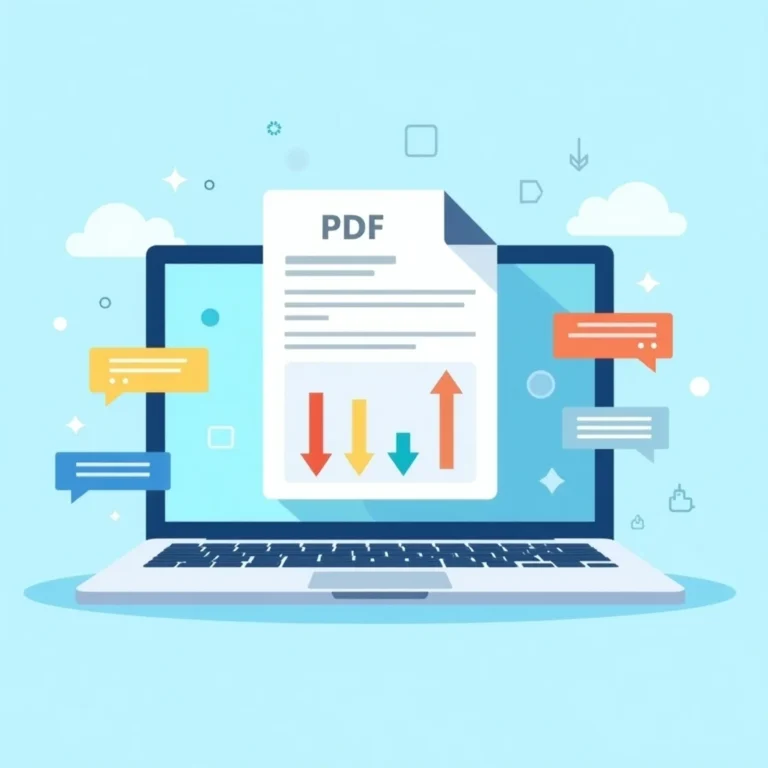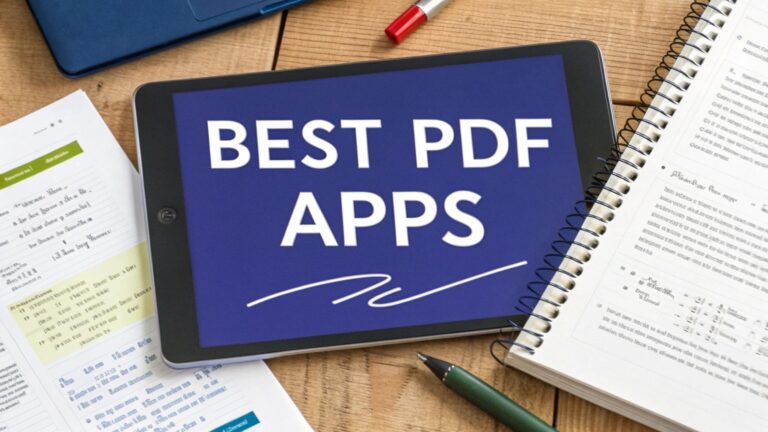Stuck in a death spiral of endless email chains, conflicting feedback, and blown deadlines? If that sounds familiar, you’re not alone. This is the unfortunate reality for teams wrestling with a broken creative review process—a system that’s supposed to guarantee quality but often just creates chaos.
But what if you could turn that chaos into collaborative clarity? That's what an optimized process does.
Why Your Creative Review Process Is Broken
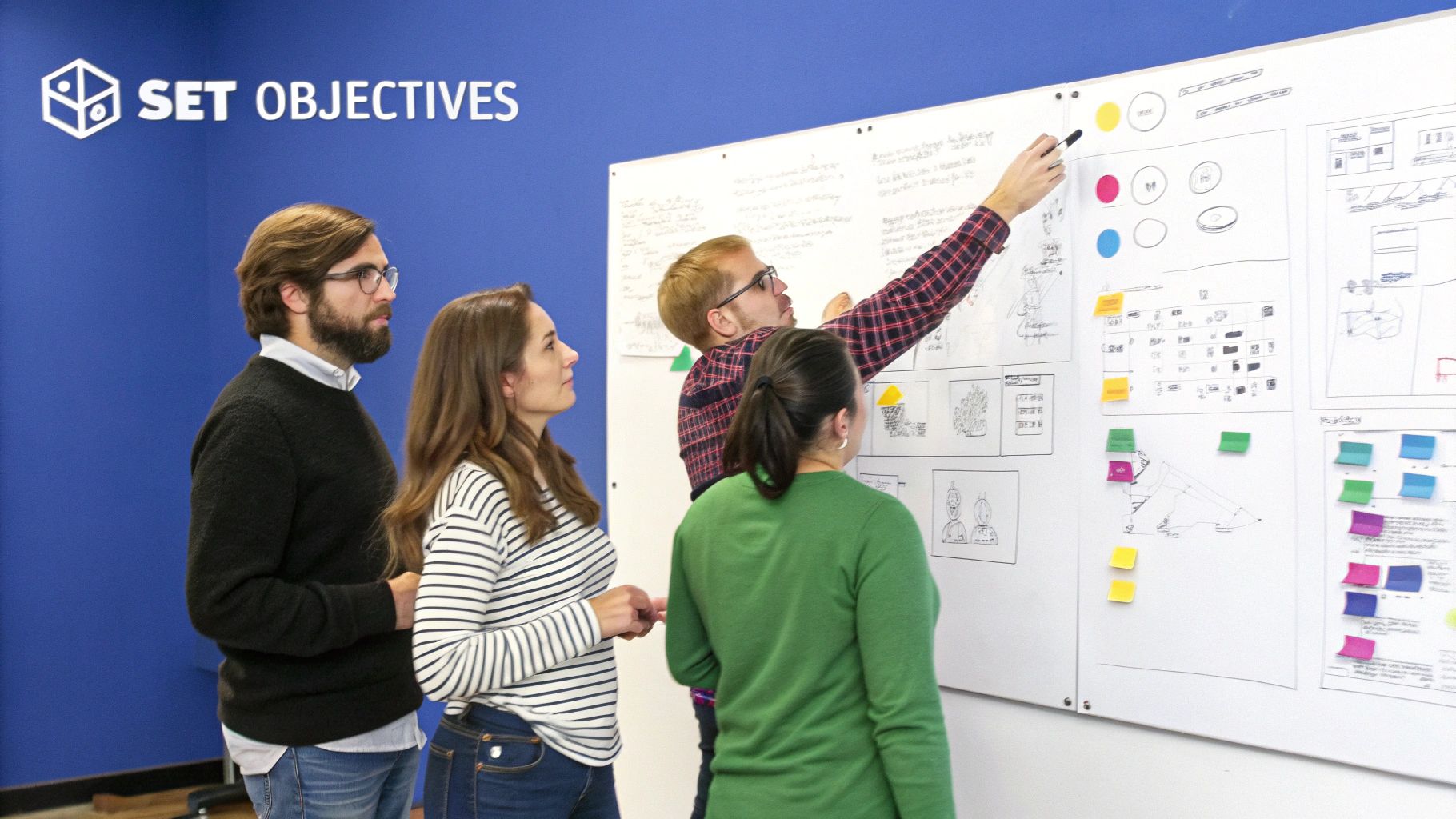
First, let's reframe what we mean by "creative review process." This isn't some rigid corporate mandate or a series of bureaucratic hurdles to clear.
Think of it as the strategic framework that guides raw ideas into polished, effective assets. It’s the difference between a disorganized garage where tools are scattered everywhere and projects stall out, and a high-performance assembly line where every single step has a clear purpose. Both might eventually create something, but only one does it efficiently, predictably, and to a high standard.
The High Cost of a Flawed System
A broken system isn't just frustrating; it has real, tangible costs that eat away at your bottom line and your team's sanity. Research shows that it now takes an average of five rounds of creative development just to get an idea signed off. This bloated cycle wastes precious time, burns through budgets, and completely erodes team morale.
The top words professionals use to describe their own review process are pretty telling: “inconsistent,” “slow,” “subjective,” and “painful.” When the system itself is the biggest bottleneck, even the most talented teams will struggle to produce their best work. It's no wonder a staggering 70% of creative agencies report they don't trust the creative judgment of the marketers they work with—a clear sign of a deep, systemic disconnect.
Creative work is only as good as the process used to develop it. The creative review is one of the key stages that is often bungled by too many cooks in the kitchen and not having a clear and constructive way to evaluate ideas.
From Frustration to Strategic Advantage
Fixing your creative review process isn't just about getting faster approvals. When you get this right, the strategic advantages ripple across the entire organization.
- It Fosters Real Creativity: When feedback is clear, constructive, and tied directly to project goals, creatives feel empowered to take smart risks instead of just playing it safe to avoid another painful review round.
- It Respects Your Team's Talent: A structured, efficient process shows you value your team's time and expertise. This leads to higher engagement and makes it easier to keep your best people.
- It Delivers Predictable Results: A well-oiled machine ensures the final product consistently hits the mark, aligning with strategic goals and delivering real business impact every single time.
Ultimately, an optimized process isn't a simple workflow improvement. It’s a competitive advantage that builds a lasting culture of excellence.
The Five Stages of a Successful Creative Review
Let’s be honest, the path from a first draft to a finished product can feel messy and unpredictable. But a solid creative review process isn’t some dark art—it’s a clear roadmap with five distinct stages. Once you understand this structure, you can transform a chaotic feedback loop into a straightforward journey to getting great work approved.
To make this tangible, let's walk through these stages using a common project that often gets derailed by feedback chaos: launching a new company website.
Stage 1: The Kickoff
This is ground zero. Before anyone even thinks about a design or writes a single line of copy, everyone involved needs to get on the same page. This isn't just another meeting; it's a mission-critical alignment session.
For our website project, this means nailing down the target audience, defining what we want users to do (like sign up for a demo), and agreeing on the core message we want to communicate. The goal here is to forge a shared definition of what "success" looks like. Without it, you're just inviting subjective feedback later on.
Stage 2: Internal Review
Once the first mockups are ready, the initial feedback comes from within the creative team. Think of it as an internal quality control check. Designers, writers, and developers put their heads together to catch any glaring errors, make sure the work actually meets the brief from the kickoff, and generally tighten up the concept.
This stage acts as a vital filter. It stops stakeholders from seeing work that’s half-baked or off-strategy, which can quickly erode their confidence and muddy the waters. The aim is to produce a polished draft that the creative team feels good about before it goes out for wider review.
Stage 3: Stakeholder Review
Now it’s time to bring in the key decision-makers—the client, the marketing director, maybe a product manager. Their job is to look at the work through a business and strategy lens. Does the website design actually sell the product's value? Is the call-to-action grabbing the right customer's attention?
To gather this feedback without it turning into a free-for-all, smart teams use a structured approach to collect and synthesize everyone's input.
This is where you bring in different perspectives to ensure the work not only looks good but also achieves its business goals.
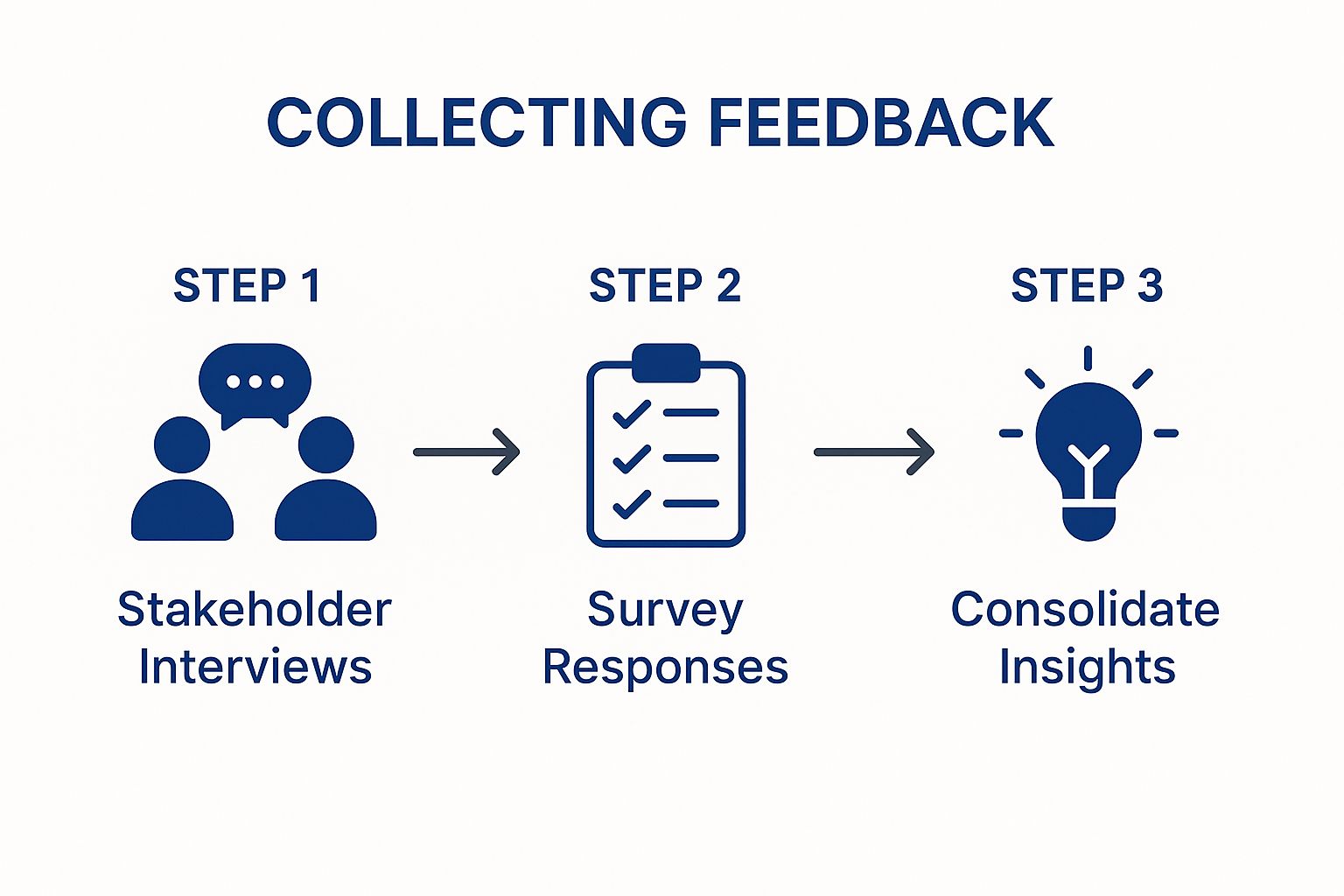
As you can see, gathering feedback from multiple sources and consolidating it into a single, actionable plan is key. It prevents the nightmare of conflicting comments from derailing the project. For a deeper dive into running these sessions effectively, especially in an agile environment, there are some great resources on mastering sprint reviews.
Stage 4: Revision and Consolidation
This is where the magic happens. The creative team takes all that consolidated feedback and turns it into concrete revisions. It’s absolutely crucial to have one person—usually a project manager or creative lead—who’s in charge of interpreting and prioritizing all the notes.
This simple step is what saves you from "death by committee," where a dozen conflicting opinions pull the project apart. A successful revision stage delivers an updated version that nails the strategic feedback from stakeholders while still protecting the creative integrity of the work.
Stage 5: Final Sign-Off
The finish line is in sight. The revised creative is presented to the final decision-maker for the official green light. If you’ve done the previous stages right, this should be a simple confirmation, not an invitation for a whole new round of feedback.
Once you get that final sign-off, the creative part of the project is officially done. For our website example, this means the design is locked and ready to be handed off to the development team to build. This final approval marks the end of the review process and gives everyone a clear signal to move forward.
To help you visualize the entire workflow, here’s a quick breakdown of each stage, its main goal, and the key things that happen.
Creative Review Process Stages at a Glance
| Stage | Objective | Key Activities |
|---|---|---|
| Stage 1: Kickoff | Establish clear project goals and a shared definition of success. | Define target audience, key performance indicators (KPIs), and brand messaging. |
| Stage 2: Internal Review | Ensure the creative work is polished, on-brief, and error-free. | Creative team (designers, writers) review, catch mistakes, and strengthen the concept. |
| Stage 3: Stakeholder Review | Gather strategic feedback from key business decision-makers. | Present work to clients or managers; collect input on business alignment and strategy. |
| Stage 4: Revision | Translate feedback into actionable changes to the creative. | Prioritize and consolidate all feedback; creative team implements the revisions. |
| Stage 5: Final Sign-Off | Secure final approval from the ultimate decision-maker. | Present the revised work for a final "go" or "no-go" confirmation. |
Following these distinct stages provides structure and predictability, helping your team produce better work with less friction.
The Business Impact of an Optimized Review Cycle
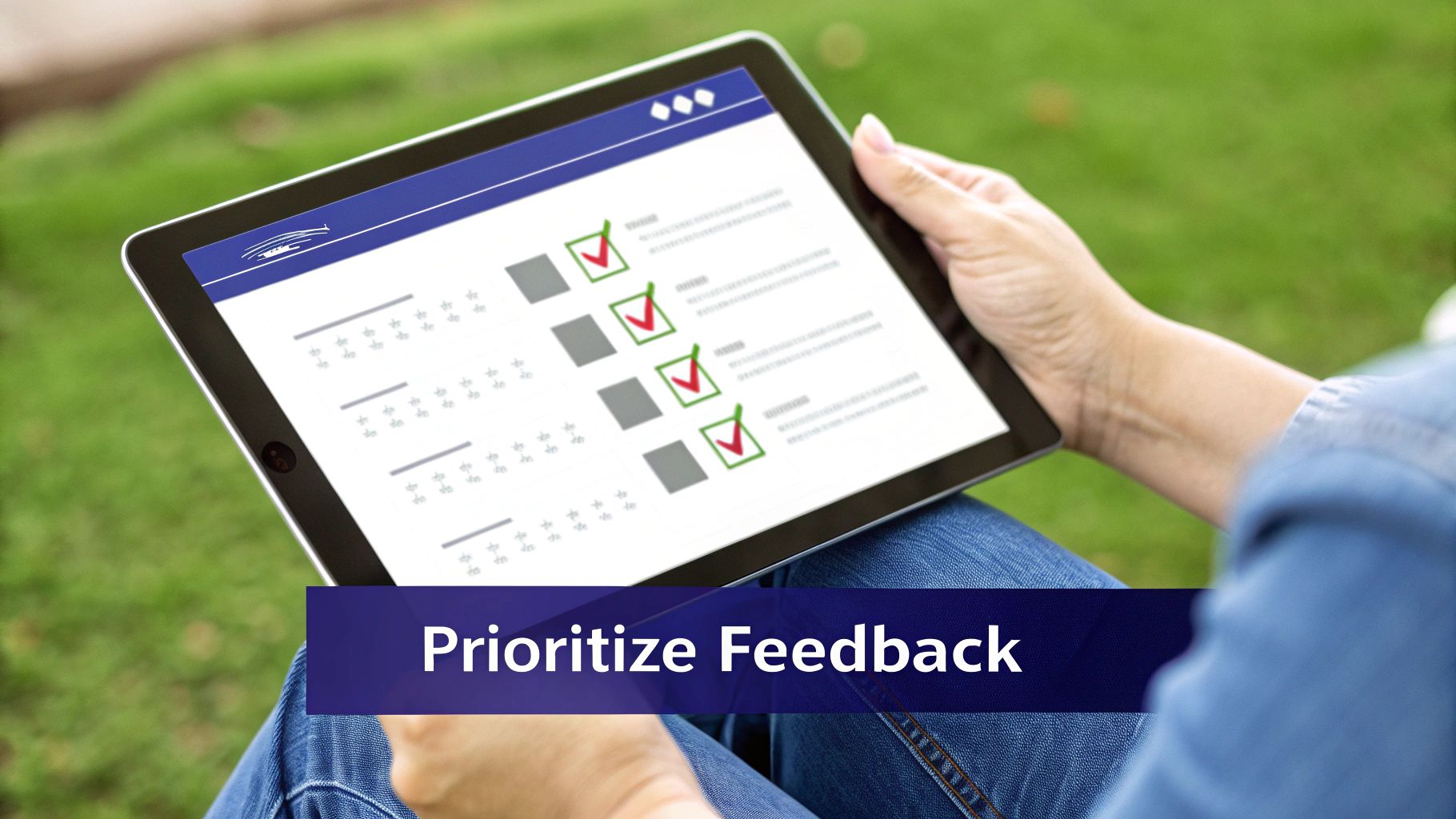
Let's be honest: a smooth creative review process does more than just make your team feel good—it directly pumps up your bottom line. It's a huge mistake to see it as just another administrative chore. Think of it as a strategic lever for boosting profits and cementing your place as a market leader.
When feedback is clear and approvals happen on time, your whole creative engine just works better. It's faster, more efficient, and way more economical. The math is simple: a well-oiled workflow cuts project timelines dramatically. You escape that soul-crushing, budget-draining cycle of endless revisions that burns out your best people. Getting killer creative out the door faster means you jump on opportunities while your competitors are still stuck in meetings. That agility is a massive competitive edge.
Driving Financial and Cultural Returns
The payoff isn't just about the money; it’s about your company's culture. Creatives who feel their work is seen and their time is respected are naturally more engaged and willing to push boundaries. A predictable review process gives them the psychological safety to pitch those big, bold ideas, because they know their work will be measured against clear goals, not someone’s random mood.
This morale boost directly impacts how long your best talent sticks around. When the system is fair and transparent, you create a place where top performers actually want to be. The alternative? A chaotic mess of conflicting feedback, which is one of the quickest ways to cause burnout and watch your creatives head for the exit.
A consistent and predictable creative review process is the bedrock of brand integrity. When every campaign, asset, and message goes through a reliable quality check, you ensure a cohesive brand experience for your customers.
This is what builds trust with your audience and solidifies your brand's reputation. It turns your creative output from a bunch of one-off projects into a powerful, unified story. When all the pieces fit together, your brand feels more authoritative and trustworthy.
The Macroeconomic Importance of Creative Work
Nailing your internal process isn't just about you; it's part of a massive global economic shift. The creative economy, which relies on these review cycles, is a huge engine for global growth. In 2022, creative services exports soared to a record US$1.4 trillion, almost double the value of creative goods. That number shows the incredible economic power of design, advertising, and digital content—all of which need a rock-solid creative review process to thrive. You can get more insights on this from the United Nations Conference on Trade and Development.
Ultimately, dialing in your review cycle is a strategic move, not a tactical tweak. For teams ready to make a change, learning the right methods is everything. You can transform your entire content review process by adopting modern proofing tools that centralize feedback and speed up approvals. This isn't just about fine-tuning a workflow; it's about building a more profitable, resilient, and creative organization from the inside out.
Common Pitfalls That Derail Creative Reviews
Even with a perfectly structured creative review process, things can still go sideways. Fast. Why? Because a few common, seemingly small missteps can act like hidden traps, derailing entire projects and turning healthy collaboration into frustrating conflict.
Learning to spot these pitfalls is the first step toward building a review process that actually works.
Imagine a design team presents a new website mockup. The feedback they get is, "It just needs more pop." This is the classic pitfall of vague feedback. It’s not just unhelpful; it's impossible to act on because it’s based on a gut feeling instead of strategic goals. To fix this, you have to insist that every piece of feedback ties directly back to the project brief. No exceptions.
Death by Committee and the Missing Leader
Here’s another all-too-common scenario: death by committee. This is what happens when you have too many cooks in the kitchen, and all of them have an equal say. The design team gets a flood of conflicting notes. One stakeholder wants a minimalist look, another demands bright, bold colors, and a third insists on cramming in more text. The result? A watered-down, Frankenstein-like design that pleases no one.
A handy rule of thumb I heard early in my marketing career: “everyone should have a voice—not everyone should have a vote.”
This is exactly why having a single, designated decision-maker is non-negotiable. This person’s job is to filter all the input, make sense of the contradictions, and make the final call. Without that clear leader, projects just drift aimlessly as the team scrambles to appease every opinion. This leads to what System1 research calls "Neutrality"—work so safe and bland that it fails to stand out or make anyone feel anything.
The Dangers of Scope Creep and Misaligned Goals
Finally, there’s the quiet but deadly threat of scope creep. The review process is for refining the work, not for adding new features or changing the game plan. If a stakeholder suddenly asks, “Can we also make this an interactive quiz?” halfway through a review, the project's timeline and budget are immediately thrown into jeopardy.
The best way to prevent this is to lock down the scope during the kickoff and treat the creative brief like a contract. When new ideas pop up—and they always do—politely park them for a future project or a separate conversation.
Here’s a quick breakdown of how to handle these common issues:
- Vague Feedback: Comments like “make it cooler” are useless.
- Solution: Mandate that all feedback must reference a specific goal from the creative brief.
- Death by Committee: Trying to please everyone leads to bland, ineffective work.
- Solution: Assign a single, empowered decision-maker to consolidate feedback and make the final call.
- Scope Creep: Adding new features or goals during the review stage.
- Solution: Firmly stick to the original brief and park new ideas for later consideration.
By actively watching for these failure points and correcting them on the spot, you can protect your projects from chaos and ensure your creative review process consistently delivers exceptional, impactful work.
Best Practices For Giving And Receiving Feedback

Here's the thing: a flawless five-stage plan is only as good as the people running it. Even the most polished creative review process can crumble if communication falls apart. The real secret sauce is mastering the human element—the art of giving and receiving feedback.
This is what elevates a process from just functional to genuinely collaborative. When everyone involved treats feedback as a gift meant to improve the work, not as a personal attack, critique becomes a powerful tool for growth. For that to happen, both reviewers and creatives need to get on the same page.
For Reviewers Giving Feedback
Your job is to steer the project toward its strategic goals, not to push your personal preferences. The most helpful feedback is always specific, objective, and points toward a solution.
- Be Specific and Actionable: Vague comments like "it needs more pop" are frustrating and useless. Instead, try something concrete: "Can we make the main call-to-action button a more vibrant color to draw the user's eye and boost clicks?"
- Tie It to the Brief: Every comment should connect back to the project goals we all agreed on at the start. This keeps the conversation focused on what will make the project a success, not on what someone subjectively "likes."
- Offer Solutions, Not Just Problems: Don't just point out what's broken. Suggest a potential way forward. This small shift shows you're a partner in finding the answer, not just a critic.
For Creatives Receiving Feedback
Learning to take critique gracefully is a skill that will define your career. Your mission is to uncover the real problem behind the feedback, filter out the subjective noise, and use the core insight to make the work stronger.
The creative review process is a delicate balance of art and science. The real magic happens when feedback is given with empathy and received with curiosity, turning a potentially tense moment into a powerful opportunity for growth and innovation.
Always start by assuming positive intent. The reviewer wants the project to succeed just as much as you do.
When a comment feels vague or just plain wrong, resist the urge to get defensive. Instead, get curious. Ask clarifying questions to dig deeper into their thinking. A simple, "Can you tell me more about what you mean by that?" can uncover the strategic concern hiding beneath a poorly worded comment. This transforms the entire dynamic into a collaborative problem-solving session.
If you're looking to really sharpen these communication skills, our guide on how to give effective design feedback offers some fantastic, in-depth strategies.
By treating feedback as a shared tool, both sides can build a culture of trust. And that leads to better work, happier teams, and projects that everyone can be proud of.
Choosing the Right Tools to Streamline Your Process
Let’s be honest: technology can be your secret weapon for a smoother, more effective creative review process. The right software doesn’t just digitize a broken workflow—it completely overhauls it. It’s about finally ditching the chaotic email threads and version control nightmares that absolutely murder productivity and creativity.
Think of it like this: you wouldn't build a house with only a hammer. In the same way, you need a dedicated set of tools to build a solid review framework. The goal here is to find software that solves your team's specific headaches, turning ambiguity into clarity and frustration into flow.
Core Categories of Review Tools
Most teams can get everything they need by focusing on three essential types of platforms. Each one is built to tackle a distinct pain point in the creative lifecycle, from that first round of feedback to getting the final files out the door.
-
Proofing and Annotation Tools: These are your front-line soldiers for getting clear, contextual feedback. Instead of vague email comments like "make it pop," team members can click directly on a design, a specific video frame, or a PDF and leave a precise note. This instantly eliminates confusion and guarantees everyone is looking at the exact same thing.
-
Project Management Platforms: Think of these as the high-level roadmap for your projects. They’re where you track stages, assign tasks, set deadlines, and make sure everyone knows who’s on the hook for what. That accountability is what keeps the review process from stalling out.
-
Digital Asset Management (DAM) Systems: Once an asset is finally approved, where does it live? A DAM is the single source of truth for all your final creative. It solves the critical problem of version control, making sure no one ever accidentally uses an outdated logo or an unapproved image again.
The real magic of these tools isn't just about moving faster; it's about creating a single, centralized hub for all communication. When feedback, versions, and approvals all live in one place, you slash the risk of miscommunication and costly rework.
Selecting Your Tech Stack
When you’re looking at different options, focus on the "why" behind each tool. Don't just grab a popular name off a list; find the platform that actually solves your team's biggest pain points. For instance, if your number one issue is messy feedback on website mockups, start by looking for a specialized feedback tool for websites to get some immediate relief.
There’s a reason this market is blowing up. Creative management platforms (CMPs)—a category that includes many of these tools—are being adopted like crazy. The global CMP market was valued at $1.20 billion in 2023 and is on track to hit $2.07 billion by 2032. This growth sends a clear message: businesses are investing serious money in technology to make creative work faster and more collaborative. You can dig into this trend by checking out recent industry reports.
As you build out your toolkit, keep an eye on how new technologies can help, too. For example, AI-powered content generation tools like ChatGPT can help draft initial concepts or even suggest feedback, adding another layer of efficiency. Ultimately, the right combination of tools frees up your team to focus on what they do best: creating exceptional work.
Got Questions About the Creative Review Process? We’ve Got Answers.
Even with the best framework in place, real-world questions always pop up when you're trying to roll out a new creative review process. Let's dig into a few of the most common hurdles teams run into on the ground.
How Do I Handle Conflicting Feedback From Senior Stakeholders?
Ah, the classic project-killer. When two different leaders give you opposing notes, trying to mash them together is a recipe for disaster. You'll end up with watered-down, ineffective work.
Your job isn't to be a people-pleaser; it's to be a facilitator. Take both pieces of feedback, hold them up against the original goals in the creative brief, and present them to the ultimate decision-maker. Ask them to make the final call on which direction best hits the project's strategic targets. This shifts the conversation from a subjective stalemate to an objective, goal-focused decision.
How Many Review Rounds Are Ideal?
While every project is different, the goal is always "as few as humanly possible." It now takes an average of five rounds to get creative work approved, which is a huge red flag for inefficiency. A healthy, well-oiled process should really only need two or three focused rounds:
- Round 1: An internal gut-check with the creative team.
- Round 2: The main event—key stakeholders review for strategic fit.
- Round 3: A final polish for any minor tweaks before sign-off.
If you’re consistently going past three rounds, take a hard look at your kickoff meetings. That’s almost always where the problem starts.
Here's a solid rule of thumb for keeping reviews on track: "Everyone gets a voice, but not everyone gets a vote." This is key to managing stakeholder input and avoiding the dreaded death-by-committee.
How Can I Get Buy-In From a Resistant Team?
Let's be real, change is tough. If your team is giving you the side-eye, you need to sell them on the "what's in it for me?"
Don't frame the new process as a bunch of new rules they have to follow. Instead, show them how it's a solution to their biggest headaches—like the endless revisions, the vague feedback, and all the time they're losing.
Try running a small pilot project to prove your point. Once they experience for themselves how a clear, structured process gets them to faster approvals with way less rework, they’ll be much more likely to get on board.
Stop chasing feedback across a dozen different email threads and Slack channels. BugSmash brings your entire creative review process into one place, letting you annotate websites, videos, and PDFs directly. Get clear, contextual feedback and cut your revision cycles in half. Give it a try for free.


